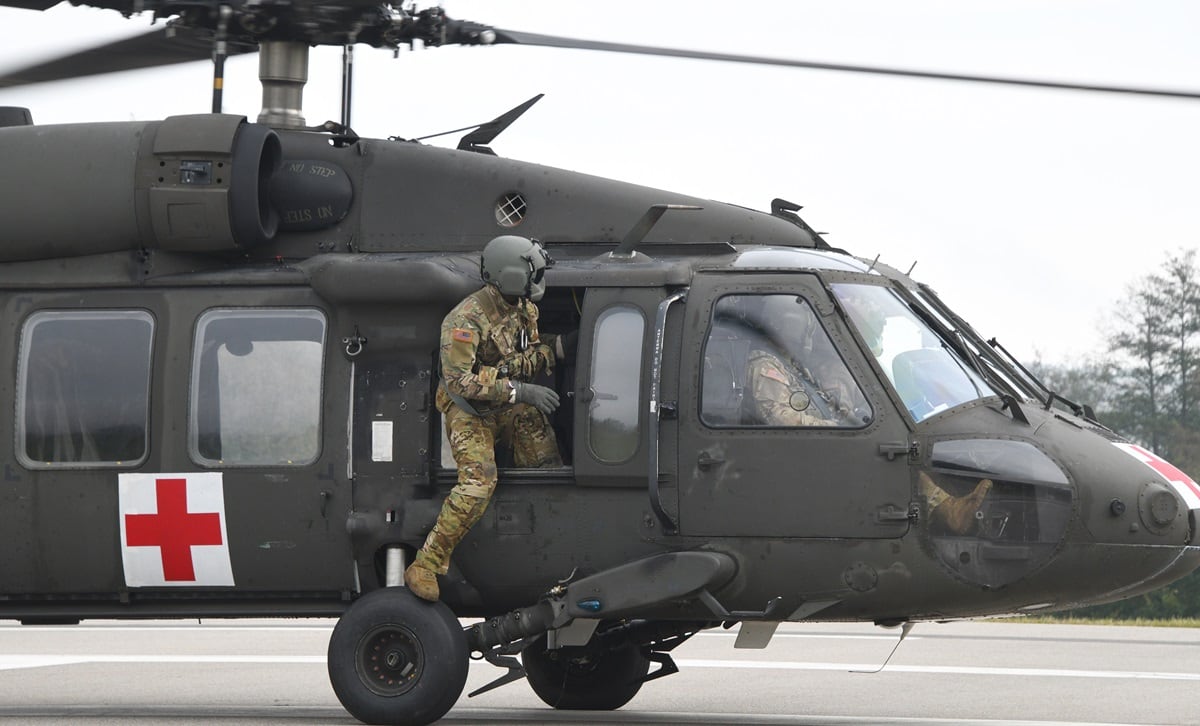While the rate of hospitalizations for active-duty troops is decreasing overall in the wake of wars in Iraq and Afghanistan, mental health related hospitalizations ― and even evacuations from deployed locations ― are on the upswing amid a growing national mental health epidemic.
That’s according to new survey data from the U.S. military’s Medical Surveillance Monthly Report. Issues published in the summer charted military health provider encounters and hospitalizations from 2018–2022, and also tracked five-year trends in troop medical evacuations for noncombat conditions.
Some of the trends are dramatic: In U.S. Central Command, the region encompassing the Middle East, medical evacuations attributed to mental health disorders have risen markedly every year since 2019.
In 2022, 38.8% of evacuations from Central Command were mental health-related, compared to 33.5% in 2021 and 27.2% in 2020. In 2022, 268 troops were evacuated for mental disorders from Central Command, out of 691 total evacuations for the region. Mental health related events were the largest evacuation category in Central Command for 2022.
RELATED

In U.S. Africa Command, where the rate of overall medical evacuations increased steeply in 2022 due to changing global force posture, mental health was the second most common cause of medical evacuations at 14.8%, behind “non-battle injury and poisoning” at 30.1%. Thirty four service members were evacuated for mental disorders from Africa Command in 2022, out of 229 total evacuations.
By comparison, the mental health medical evacuation rate from Iraq was 11.6%, about one-third of the current rate, for the nine years between 2003 and 2011, according to Medical Surveillance Monthly Report data.
All troops were evacuated to the U.S. or Europe, where they saw a medical provider for further treatment, according to report criteria.
In-theater medical encounters attributed to mental health disorders also are on the rise overall. Those increased from 4.4% to 6.2% during the five-year surveillance period, with “adjustment disorder with mixed anxiety and depressed mood” topping the list of mental health conditions requiring an encounter.
Stateside, data shows that rate and numbers of active-duty and reserve component hospitalizations decreased from 2018 to 2022 “for all major diagnostic categories except mental health disorders.” Those saw a slight increase, from 5.7% to 5.9%.
Mental health disorders topped the list of reasons for hospitalization for every year in the survey data, but the number of hospitalizations in 2022, at 19,079, was 1,000-plus more than the number in 2018, which was 18,012.
In the same period, hospitalizations for injury and poisoning dropped by nearly 1,600. And those for musculoskeletal issues dropped by by nearly 1,700. Total hospitalizations for all conditions dropped nearly 14%, from 66,128 hospitalizations to 57,009 hospitalizations.
While ambulatory visits ― those not requiring a hospitalization ― for mental health disorders were only the third most-common category for service members, behind “other” and musculoskeletal system issues, the visit rate for mental health issues were dramatically on the rise.
Mental health-related ambulatory encounters rose 20% from 2018–2022, from 1.9 million to 2.3 million. Here too, adjustment disorders topped the categories for these visits.
The increase in military mental health issues requiring treatment or intervention has not occurred in a vacuum.
An estimated one in five American adults now live with a mental illness, and the COVID-19 pandemic triggered a global increase of about 25% in the prevalence of behavioral health conditions including anxiety and depression, according to the World Health Organizations.
In the military, a rise in medical provider encounters for mental health disorders is not necessarily a bad thing, said Dr. Kimberly Hepner, a senior behavioral scientist at Rand. It speaks, she said, to efforts in the military and in the civilian world to destigmatize the process of seeking treatment and establish an understanding that “mental health care is health care.”
The stressors and shared experience of COVID-19, she said, contributed to that mindset shift.
On the other hand, a rise in mental health-related evacuations for deployed troops represents a clear concern, Hepner said. She pointed to a widely acknowledged shortage of in-house military mental health providers that parallels a national shortage of behavioral health clinicians.
Because of this shortage, she said, more troops are receiving behavioral health care from the private sector, through civilian providers contracted by the military’s Tricare health system. Though this is a better solution than allowing mental health needs to go unmet, she said these contracted providers are less likely to understand the readiness requirements for deployment.
“If I were sitting at a military training facility, assessing readiness at every session would be my bread and butter,” she said. “But a provider in the community may not understand those issues as well; they may be newer to seeing service members and not as well versed in the need to assess readiness.”
As a result, she said, service members who are not psychologically healthy enough to handle deployment stressors may be getting cleared for deployment more often. And this is a serious concern, she said, as it’s disruptive to the military’s ability to carry out forward missions effectively.
According to the recent Medical Surveillance Monthly reports, the most common diagnoses associated with medical evacuations from Central Command and Africa Command in 2022 were “reaction to severe stress and adjustment disorders.”
“Depressive episode,” “major depressive disorder, recurrent” and “other anxiety disorders” also were high on the list.
For Hepner, the clear solution is to increase the number of behavioral health providers inside military treatment facilities ― a process that she acknowledges could take time. She also said the military likely needs to understand more about the underpinnings and precursors of these mental health-related medical evacuations, and examine the existing efforts to screen and assess troops prior to deployments.
“Something potentially could be missed at that stage, even though the readiness assessment right now is quite extensive,” she said. “And so there are questions about, how could that process be improved.”
As all the military services face historic challenges in meeting recruitment goals, some have sought ways to accommodate prospective enlistees with histories of mental health issues.
The Army in 2018 changed policy to allow potential recruits with a past incident of self-harm before the age of 14. Some lawmakers now want a full removal of exclusions for prospective recruits who’ve sought mental health care in the past.
Hepner said it’s important to remember that a mental health care encounter or hospitalization doesn’t preclude a return to full health and duty capability, and in fact that that’s the common outcome of behavioral health treatment.
“I think we want to continue to highlight that this is care that all service members should have access to, and that getting access to high quality behavioral health care, will help service members return to full duty and complete their mission,” she said. “And we want to support them to be able to do that.”
Editor’s note: This story was updated Nov. 13 to correct the spelling of Dr. Kimberly Hepner’s name.
Hope Hodge Seck is an award-winning investigative and enterprise reporter covering the U.S. military and national defense. The former managing editor of Military.com, her work has also appeared in the Washington Post, Politico Magazine, USA Today and Popular Mechanics.





